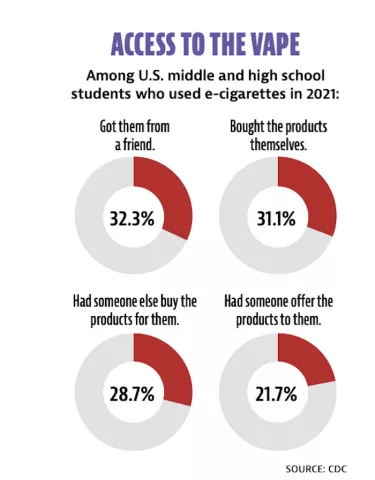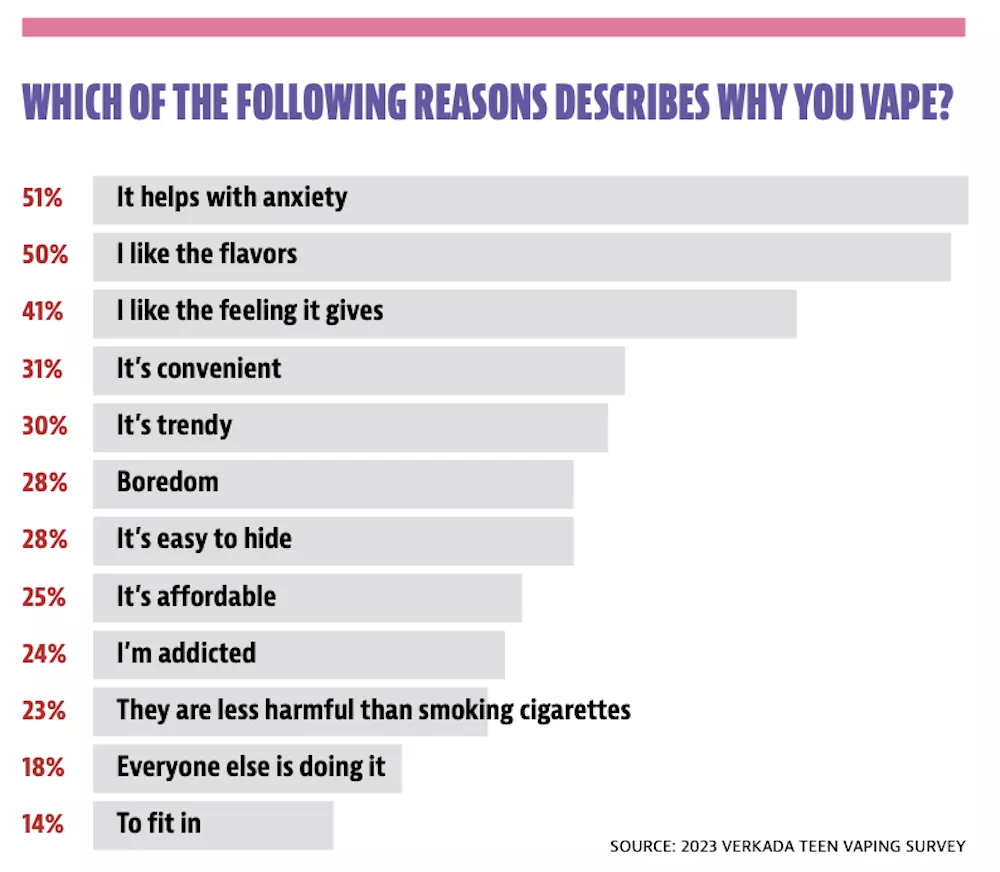Key Takeaways
- Despite recent data showing a decrease in student use of e-cigarettes, too many students across the country vape daily.
- Vapes are extremely dangerous, and a cause for concern given their popularity among middle and high school students
- Experts say schools and educators must continue to play a major role in vaping and tobacco use prevention.
A high school student paces by the classroom door as the clock ticks down, indicating it is almost time for the next period. Another student is irritable all class, often talking back and interrupting instruction. A third student leaves the classroom at the same time every day, likely meeting up with friends in the bathroom. What is the common denominator among all these teenagers? Many educators will tell you: It’s the vape in their pocket.
“That’s really challenging when you’re trying to engage a kid in class or trying to introduce new content. It’s hard when a kid is just having a fiending for nicotine,” said Lillian Barry, a school counselor at Hermon High School in Hermon, Maine.
E-cigarettes, also known as vapes, came onto the market in the United States in 2007, according to the Mayo Clinic. The amount of nicotine vape products contain varies depending on the brand of the vape and the size. When an individual inhales vapor laced with nicotine, the drug is quickly absorbed through the blood vessels; research shows that the nicotine inhaled can reach the brain in as few as 10 seconds. As a result, users, who are often young people, quickly become addicted - and the data show more middle and high school students are using vapes now than they did just a year ago.

In early 2024, the Food and Drug Administration and Centers for Disease and Prevention conducted its Annual National Youth Tobacco Survey, collecting data on tobacco use among middle and high school students. According to the survey, 5.9 percent of middle and high school students use e-cigarettes, a drop from 7.7 percent the previous year. More than a quarter of those students reported using e-cigarettes every day. Despite the encouraging trend, the CDC cautioned that vaping remained very harmful and was still too prevalent among U.S. students.
“I think there is a false sense of security that it is safer because it is not a cigarette,” said Paulette Luckett, a school nurse in St. Louis Public Schools.
But research shows that vapes are extremely dangerous, and a cause for concern given their popularity among middle and high school students, according to Elizabeth Crespi, M.P.H., graduate research assistant from the Institute for Global Tobacco Control (IGTC) at the Johns Hopkins Bloomberg School of Public Health. Crespi explains that nicotine is what makes e-cigarettes addictive, but there can be other toxic chemicals in the ingredients or in the aerosol, adding to the potential health risks.
“We have more than 100 years of research to prove how dangerous cigarettes are, but because e-cigarettes were popularized more recently, no one knows yet how damaging they will be to the people who use them in the long term,” Crespi said, while still emphasizing that any vape use can have serious health implications. The CDC stresses the health issues associated with nicotine--citing impacts on brain development and addiction--which in youth can begin quickly among young people, sometimes before the start of regular or daily use.

For a young, impressionable student, vapes’ enticing packaging, form, colors and flavors can be a powerful draw, according to the Mayo Clinic. According to research, other factors driving vape use include, peer pressure, stress management, the fact that vape is less detectable than cigarette smoke, the idea that vaping is cool, the false belief that vapes are safer than cigarettes, and exposure to an influential parent or sibling who vapes.
“The tobacco industry makes e-cigarettes that align with current consumer trends and come in a wide variety of appealing flavors,” Crespi said. “The tobacco industry is using e-cigarettes as an onramp for new consumers to start using their products.”
As Luckett and Barry work to get their students to abstain from vaping, they realize what they’re up against. They agree the aesthetics of vapes appeal to students; but what’s more troubling is that vaping is trendy and bestows a certain “status” among their peers. Both education professionals said vapes are easy to sneak, which appeals to a student’s desire to rebel.
“I think certainly, if you’re also looking at social media, this is again just perceived as normalized and as cool, and not harmful. When realistically, it’s exceptionally harmful,” Barry said.
Social pressure is a common pattern that Barry sees among students she works with. She said she has heard from students that they will hold a vape at social gatherings instead of drinking alcohol because they don’t want to jeopardize their athlete status or because they need to drive home after the gathering. “They’ll intentionally hold a vape [so] somebody won’t ask them to drink a beer,” Barry said. “They’re still like, ‘No, this kid’s cool.’”
Vaping and Mental Health
Other than the trendiness of vaping, research shows young people vape to decrease stress, anxiety, or depression. Verkada’s 2023 Teen Vaping Survey of 2,650 Americans – including parents, teachers, vaping teens, and non-vaping teens – to better understand vaping patterns.

The Verkada survey, from a company that in part focuses on air quality, found that 51 percent of students who vape said it helps with anxiety.
“I think it’s a stress relief for kids,” Barry said. “You know, it’s a kind of this coping mechanism for stress, anxiety, maybe any type of emotional concern or issue that they may be having.”
Yet, vaping can make anxiety and depression worse. Newport Institute explains that when a young adult tries to quit vaping, their mental health can suffer because of nicotine withdrawal symptoms. This makes it less likely for users to quit.
“It’s a slippery slope because nicotine does give you this rush of, ‘Hey I’m feeling okay now,’ but it’s heavily addictive,” Barry said.
The Verkada survey found that students still choose to vape despite knowing the consequences. “Nearly all teenagers who vape (96%) view teen vaping as a problem, with 61% of vaping teens considering themselves to be addicted and 54% wanting to quit vaping altogether.”
Nicotine Influences Behavior
In the Verkada survey, teachers reported that vaping had a significant impact on student behavior with nearly 9 in 10 teachers saying vaping is disruptive to learning environments.
Luckett and Barry, who have seen these disruptions firsthand, work to manage the difficult behaviors while still trying to create a safe learning environment. It’s an increasing challenge as a student’s behavior can depend on the substance inside the vape. “If it’s a vape that has nicotine, maybe it’s flavored, you have kids who are addicted to it, so they become anxious when they can’t get their ‘fix’,”Luckett explains.

When a user does not have access to their nicotine, they become agitated and sometimes belligerent, said Luckett. She compared vapers exactly to cigarette smokers: “When you need your cigarette and can’t get it, it can cause an issue because you are addicted.”
Luckett then detailed the change in behavior she sees if a student is using a vape that contains substances other than nicotine, like the CBD or THC found in cannabis.
“If you have a kid who’s doing it regularly, you may have a kid who comes in hyper laid back and really relaxed compared to what they would normally look like because basically, they’re high, which happens to cause an issue with learning and doing their day-to-day school,” Luckett said. “You need to be sober in order to learn.”
Barry said that in her school district, an increase in irritability and anger-motivated behavior in students who vape has resulted in an increase in discipline from staff.
“We are seeing just this kind of vicious little cycle of kids that are either reporting other kids because they’re angry, or they’re planting things because they’re angry with a kid.
They’re trying to sell [vape] pods at school and they’re trying to distribute things,” Barry said. There also has been an increase in students missing class at Barry’s high school, as vaping students will meet up with their peers in the bathroom during instruction time.
Barry’s school requires students caught with a vape to meet with a certified alcohol and drug counselor. She said that the impact on the school community is substantial because administrators must work with counselors to discipline the student’s behavior, which then requires educators to intervene to catch the student up in class.
What Can Educators Do?
Vapes are hard to detect as they are small, and the scent does not attach to the breath or clothing of users like cigarettes smoke. Because of this, schools have turned to metal detectors to catch a vape the moment it passes through the school front doors or vape detectors in bathrooms to detect the puff of aerosol mist in the stalls.
Barry said her school has also turned to more creative measures like an electronic hall pass system to track patterns among students who leave the classroom frequently to meet up with friends in the bathroom.
Both Barry and Luckett said that these methods are not enough to stop the vaping problem in their schools, though. They are asking for help from parents and guardians to address the vaping issue at home so they can focus on education in school.
“Parents are going to have to take a more active role and not just let the school do it, because schools aren’t doing it. And even if they were, parents have got to discuss these types of topics with their children, and especially if you’re a parent that participates in vaping yourself. Be open and honest, explain the dangers and what it can do, and that those age limits are there for a reason,” Luckett said.
Luckett said that many places no longer require health education classes, which is a big mistake. She said that schools are seeing issues with vaping because they are not adequately educating their students on the matter.
In Maine, Hermon High School incorporated a new required health course into the curriculum after an advisory board and student panel worked to determine exactly what students need to learn to be successful. The new course focuses on vaping, and on educating students on how to handle peer interactions and develop refusal skills with the hope that this will curb unhealthy behavior.
Even with the course, the high school counselor worries there is a lack of resources for students and parents regarding vaping. “If we could just—as a community, as a state, as educators—work together to really build some strong resources to help support these families, that would be so helpful,” Barry said.
Crespi emphasized that education and support are essential for helping young people combat their vaping addictions.
“We cannot squander the opportunity to prevent future generations from susceptibility to a lifetime of nicotine addiction and tobacco use,” Crespi said. “Education is critical for informing students and young people about the dangers and addictiveness of tobacco and nicotine products. Teachers can also help by staying abreast of approved cessation tools and steering students who want to quit to available resources.”



